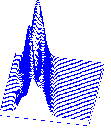
It is difficult to see something with dimensions 2.82×10-15 m or less*. But sometimes one can succeed – observing not exactly an electron but its path – an orbital.
What was untill recently only a mathematic formula, a probability plot or just an artistic “shadowing”.
Moreover, ultrafast lasers
(there are several in Milano) allow to trace the electron motion after being
ejected from an atom in an ultra short time (10-18 s).
 - behave similar to waves on the water surface, when a drop falls on
it
- behave similar to waves on the water surface, when a drop falls on
it  .
.